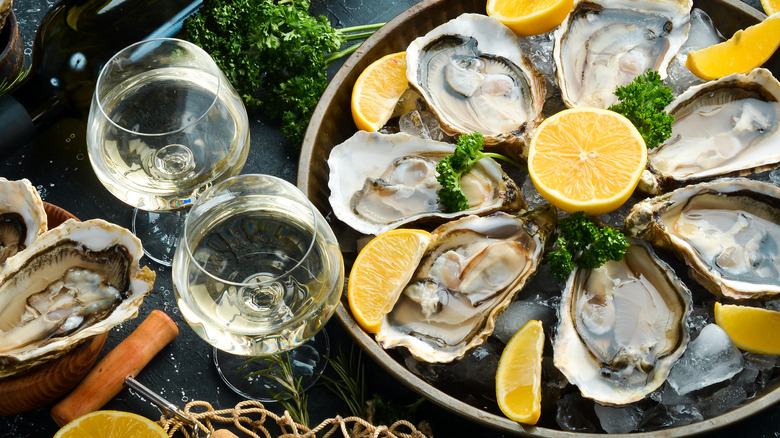The Real Difference Between Farmed And Wild Oysters
It seems everyone is slurping oysters, with raw bars cropping up in coastal enclaves and large cities alike. Boston.com reports that between 2008 and 2014, the farmed oyster sector grew by $80 million, coming in just behind scallops and lobster to become New England's third-largest fishery.
According to Insider, oysters have been around since at least the Palaeozoic period (that's 300 million years ago). But they weren't always the starter of choice. In the 19th century, oysters were ubiquitous and cheap. As Michigan State University explains, harvesting by hand with tongs was replaced by dredging mesh bags along the ocean floor. This innovation made oysters so plentiful that their prices plummeted, enabling working class folks to enjoy them. New Yorkers during that time ate an average of 600 oysters per year, and they were found everywhere, from bar snacks at taverns to meat pie makers. It wasn't long before a perfect storm of over-harvesting, disease, typhoid outbreaks, and Prohibition ended the oyster's reign.
In the late-aughts, aquaculture brought oysters back from the proverbial dead. In 2007, The New York Times reported that a strain of oysters bred to be disease resistant was thought to be behind a resurgence of oysters in the waters around New York and neighboring New Jersey and Connecticut. Virginia Business credits the aquaculture industry for a Chesapeake Bay oyster renaissance, a boon to both business and taste buds.
Now that the succulent bivalve has made a comeback, thanks largely to aquaculture, let's dig into some of the differences and similarities between farmed and wild oysters.
Do wild and farmed oysters taste the same?
Wild oysters take three years to grow large enough to consume. Because they reproduce during the summer, Hobby Farms says the meat from summer-harvested wild oysters loses its rich flavor. Farmed oysters, on the other hand, are sterile. Since they don't reproduce, they are yummy year-round. They also mature faster — it takes them only two years to grow to their harvesting size.
Unlike other farm fisheries, oyster farms are good for the environment. National Geographic points out they have practically zero environmental impact; in fact, oysters clean pollution from the waterways, clearing the water so that sunlight penetrates ocean depths, which prompts sea grass growth. Farmed oysters are credited for the resurgence of their wild cousin, whose reefs were nearly wiped out by 2012.
As for taste, Pangea Shellfish notes that an oyster's flavor is dependent on the water where it grows, leaving no discernible taste difference between farmed or wild. Hobby Farms further explains that an oyster's flavor — its merroir — is similar to wine's terroir. Water salinity affects the taste, as does the amount of time spent out of the water. Because oysters grow in low or tidal lands, they are submerged in water only part of the time. Finally, farmed oysters are specifically raised to be eaten on the half shell, so they are bred to have deeper shells to hold the liquid that gives them their flavor. Edible Delmarva says this gives the farmed bivalves a more consistent flavor.

